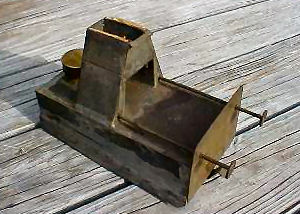|
|
Light in the darkness
|
|
Without the presence of light no magic lantern might exist. Therefore one of the most important parts of
a magic lantern is ....... the light source. | ||
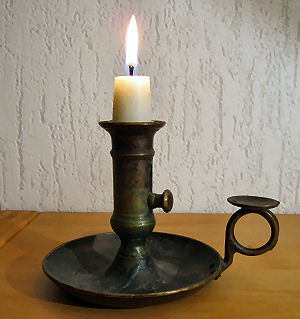 |
Candle. The first light source ever used in the magic lantern is a simple candle, in those days made of real beeswax. Candles however were comparatively weak illuminants; also, when they burnt they became shorter and the position of the wick got lower, so the flame continual became out of optical alignment. Therefore soon the candle was replaced by the oil lamp. The standard 'Candle' became a measurement of light source intensity. It was originally defined as a one-sixth-pound candle of sperm wax, burning at the rate of 120 grains per hour. | |
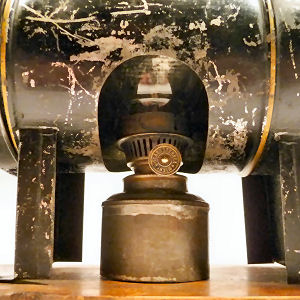 |
Oil lamps. | |
| The first little oil lamps burned a variety of oils including vegetable oil, sperm oil, paraffin, whale oil and others. The oil lamp was one of the simplest to use. However some care was needed to position the flame at the focal point of the condenser lens, and it was also necessarily to trim the wick properly because an overlong wick produced a wobbly and unfocused light. A wick that was too short would burn poorly by a shortage of oxygen. | ||
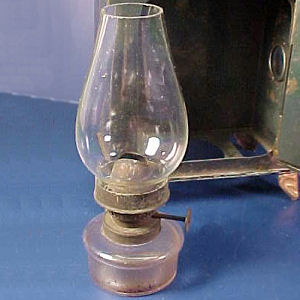 |
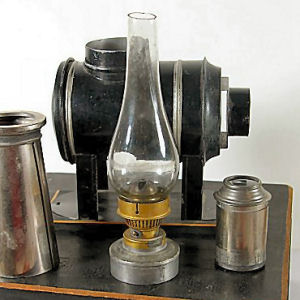 |
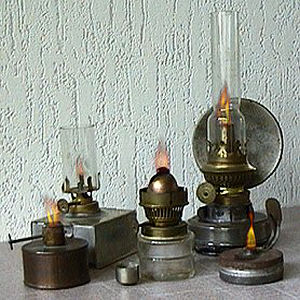 |
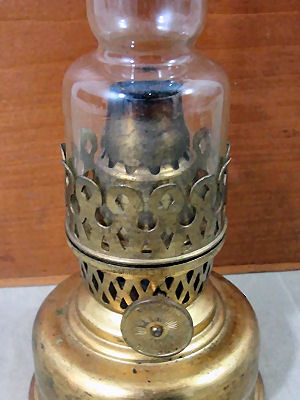 |
Argand
lamps. The Argand lamp, which was invented in 1784 by the Swiss physicist François Pierre Ami Argand, was a major improvement in brightness compared to the traditional open-flame oil lamps. The lamp was provided with a circular wick that was fed with oil through a small tube and was mounted between two concentric cylinders. The free flow of air increased the brightness of the light and the steadiness of the flame significantly. By placing a reflector the light could easily be concentrated in the optical axis of the lantern. |
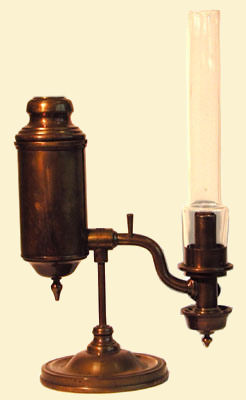 |
| From the late 18th century Argand lamps were the best oil illuminants until they were superseded by Marcy's multiple wick lamps. | ||
|
Multiple wick lamps. |
||
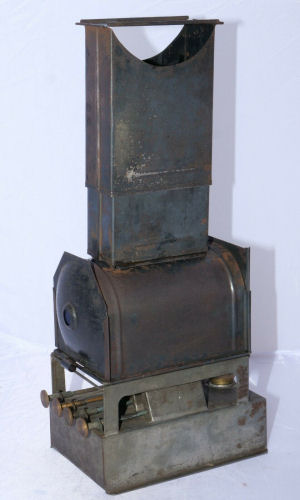 |
|
In 1872 L.C. Marcy of Philadelphia developed an oil lamp for his 'Sciopticon' magic lantern that used two parallel placed flat wicks which almost touched each other at the tops. The edges of the wicks faced the condenser lens. Marcy achieved with this lamp a level of brightness equal to forty candles thus making it the best oil lamp available at the time. |
|
Of course Marcy's principle was
soon copied and improved by other manufacturers of magic lanterns. The London manufacturer Frederick Newton
produced a two-wick burner which was provided with a very tall chimney and this
lead to improvements that had three, four and even five wicks. Each wick could
be controlled separately and a frequent adjustment of the individual wicks was
necessarily. The position of the wicks could be viewed through a small blue glass window
in the back. Also the chimney height was mostly adjustable to regulate
the draught. | ||
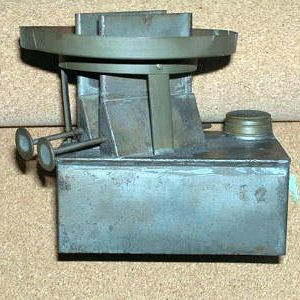 |
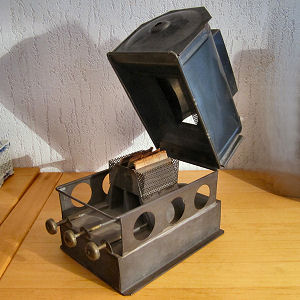 |
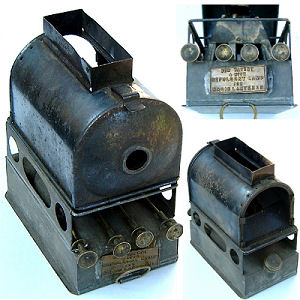 |
| Two wicks. | Three wicks. | And even four wicks. |
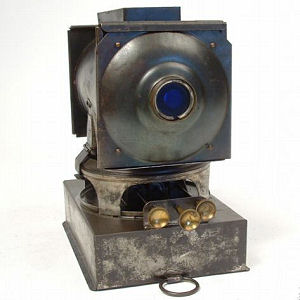 |
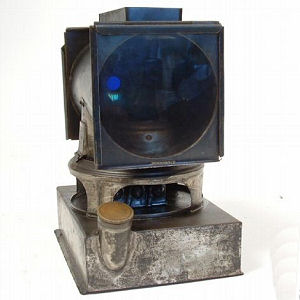 |
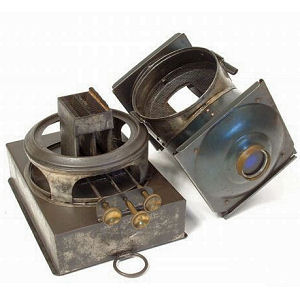 |
| Three wick oil lamp used in an 'Optimus' magic lantern made by Perken Son & Rayment, London. The base is an oil tank with a brass filler cap and an impressed trademark. A triple wick assembly is fitted to the tank and this has three good wicks with separate controls. The box-shaped top of the burner has a blue glass peephole to the rear and, at the front, a clear glass window. The whole top is hinged at one side. The chimney fits directly on to the burner through an opening in the top of the lantern. | ||
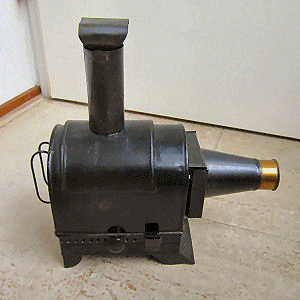 |
In
the time between the period of candles and little oil lamps, and the
period in which the use of electric light became common, all kinds of
light systems were used mixed up and side by side. Usually the light system was not included in the price of the magic lanterns, so that the customer was able to choose the light source that matched his personal wishes and circumstances. A lot of magic lanterns however were provided with a built-in oil lamp. Oil lamps remained frequently in use after the discovery of much better sources of light. | |
|
However despite the many improvements and modifications made to oil lamps their light remained very feeble. While they were still fitted to magic lanterns used at home and for small public gatherings, the limelight and later the electric arc became the normal source of illumination for exhibitions in large public halls.
|
||
Limelight.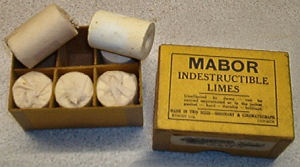 |
The limelight is a very bright gas lamp, invented in 1825 and widely used
for magic lantern illumination and theatrical lighting until about 1900. It
consists of a block of lime (calcium oxide) heated in an oxyhydrogen flame. The two gasses oxygen and hydrogen are fed in from outside by a pipeline system with valves. The flame from the nozzle heats the cylindrical lime block, which thereupon glows white hot. The jet is fitted with a mechanism with lever taps and cogwheel adjustment for turning and raising the lime block. This limelight produces up to 1,000 candles |
|
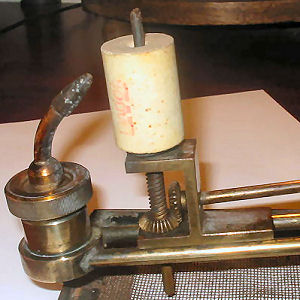 |
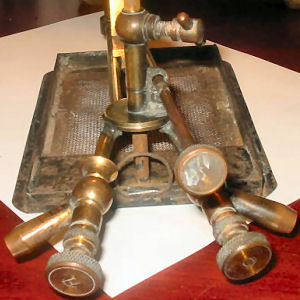 |
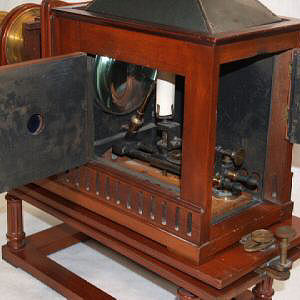 |
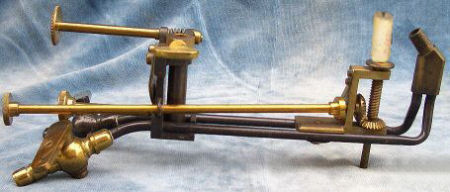 This lime light burner is signed at the rear KERSHAW'S PATENT, W.I.CHADWICK MANCHESTER. |
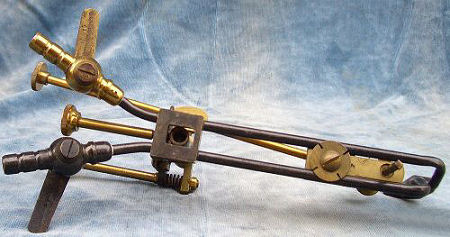 |
||
|
Methylated Spirit Burners. |
|||
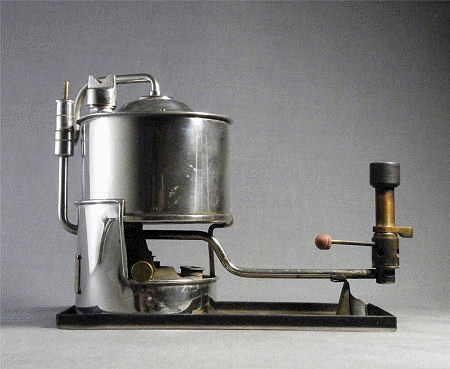 Methylated Spirit Burners were largely used, and provided a light decidedly superior to gas and nearly equal to acetylene. In this apparatus the spirit is contained in a metal reservoir at the rear and air pressure is provided by a pair of rubber balls. A much better arrangement is that made by Hughes. In this burner there is no pump and no volatilising chamber; the spirit is contained as before in a metal reservoir and a separate burner underneath is used to keep this sufficiently hot to both vaporise the spirit and provide the necessary pressure. The heat can be regulated by means of an adjustable sheath to the burner, and a simple safety valve provides against an excess of vapour. |
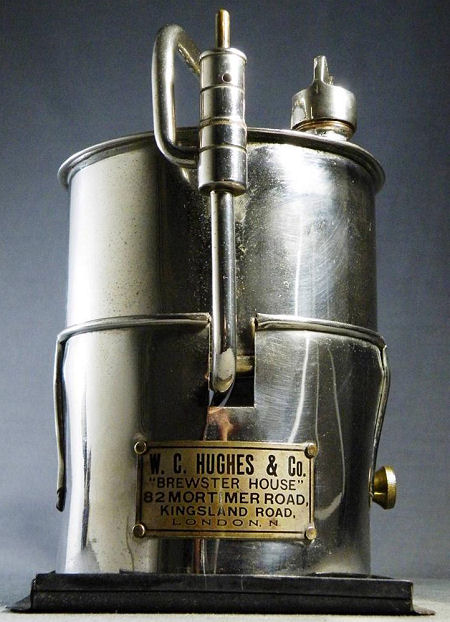 The LUNA lamp, invented by W.C. Hughes, London. | ||
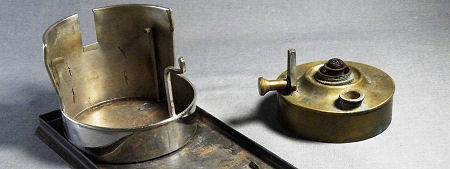 |
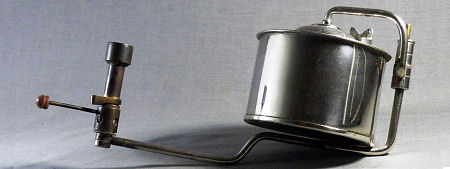 |
||
|
Saturators. |
|||
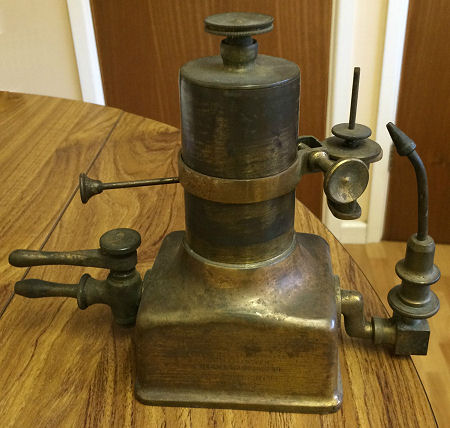 |
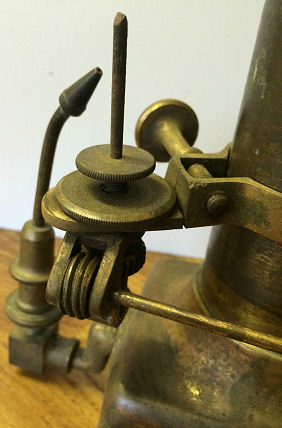 | ||
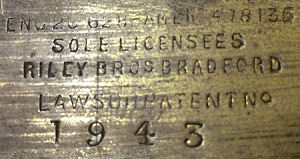 The Lawson saturator (patented in 1893) incorporated saturator generator and jet in one unit for use inside the lantern. |
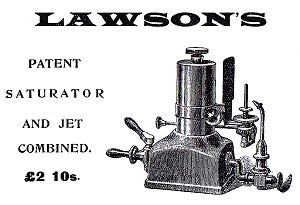 The Oxy-ether
saturator enjoyed a brief period of popularity though some contemporary sources
said it was a very dangerous lamp. However most agreed that it was also
convenient, because it required no fuel gas but only oxygen in a gasbag or
cylinder.
The Oxy-ether
saturator enjoyed a brief period of popularity though some contemporary sources
said it was a very dangerous lamp. However most agreed that it was also
convenient, because it required no fuel gas but only oxygen in a gasbag or
cylinder.The purpose of the saturator was to mix the fumes of ether (benzoline) with oxygen to form a highly combustible mixture which was burnt at the nozzle of the limelight, thus producing a very powerful light suitable for small halls and homes. |
|
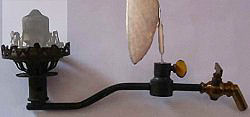 |
Incandescent Gas burner. |
|
This are lamps that used a mantle consisting of a
cylindrical fabric impregnated with a mixture of rare earth that was heated in a
gas flame and became incandescent. They were generally used for house lighting. It was not considered suitable for use in the magic lantern, as it delivered its light over a large surface area and lanterns worked best with a light of small surface area. In light the gas burner is very little superior to oil. |
|
|
Oxyhydric lamp. |
|
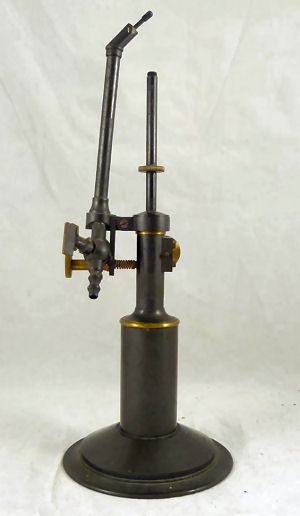 |
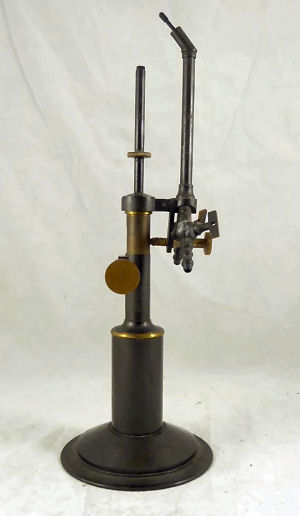 |
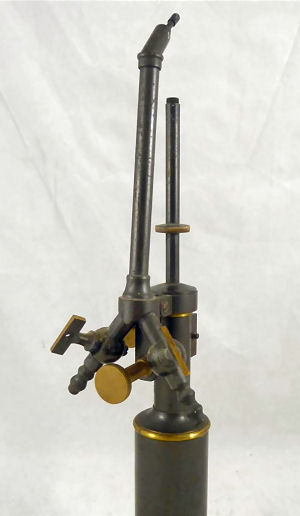 |
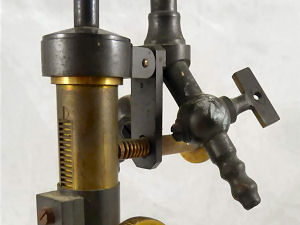 |
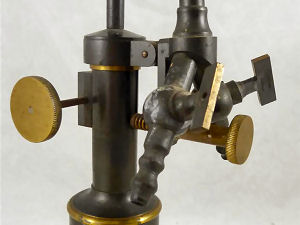 |
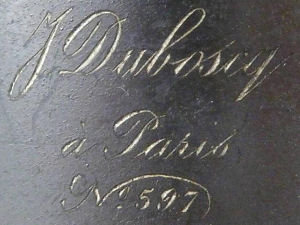 |
| French
Oxyhydric lamp made by Jules Duboscq, Paris, circa 1880. An extremely bright light is produced by heating a lime rod with a mixture of oxygen and hydrogen. This was supplied by two separate gas pipe tap feeds marked O and H. The angle of the flame is adjusted with one wheel and the height of the lime with another. This high quality all brass lamp was principally used for scientific/optical experiments. Height 14" or 350mm. The 'Lampe Oxyhydrique' is a rare lamp with few examples known. Mixing hydrogen and oxygen would have been a very hazardous enterprise and this idea probably never took off. The carbon arc lamps appeared to be a better solution. | ||
|
Acetylene jet lamp. |
|
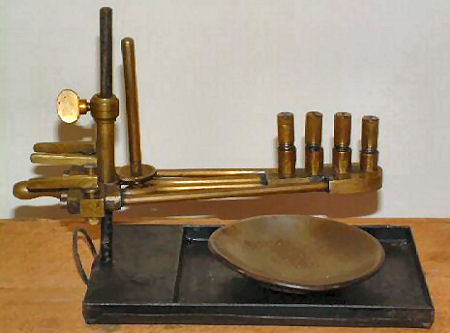 |
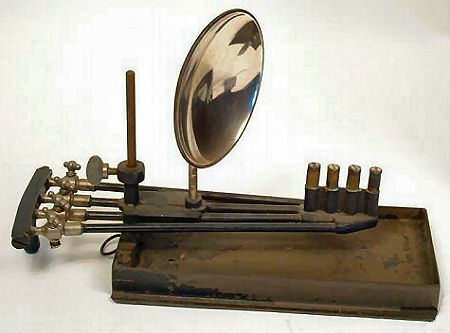 |
|
Acetylene gas is formed when water comes
into contact with calcium carbide, while the oxigen in the water unites with
the calcium to form calcium oxide, or lime. Lanternists had to buy the carbide in
shops and and they needed a special generator to produce the gas. In this
generator the carbide came in contact with a controlled supply of water. The
resulting acetylene passed to the lamp through rubber tubes. The lamps were simple and cheap and
produced a steady smokeless flame. They are provided with sets of
two, up to five burners arranged in-line behind the condenser lens.
When burnt in a jet the gas produced a bright light without the
need for a gas mantle as was the case with most mains gas. However there were
also some objections. The acetylene gas could corrode the brass nozzles on the
lantern; that's why they were sold separately. Another objection was the forming
of a black smut and an unpleasant smell that could fill the room. | |
|
Carbon arc lamp. | ||
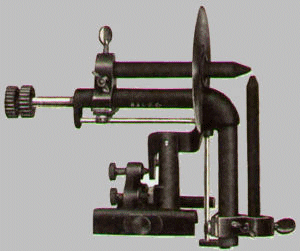 |
The biggest
projection devices often used carbon arc lamps, which were employed a
considerable time, also after the development of the electric light bulb. A couple of touching carbon points were connected to an electric power source. When the rods were pulled apart slightly, this produced a bright electric light, caused by the incandescent carbon particles that burned between the points. Since the carbon rods are gradually consumed, one had to adjust the rods continually to maintain the correct distance between them, and the correct position relative to the optical centre of the lantern, during the show. This difficult job was later often achieved by an automatic regulator. | |
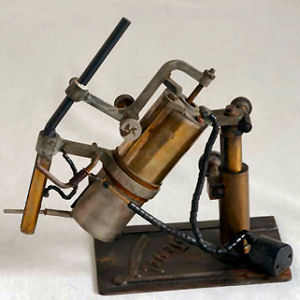 |
 |
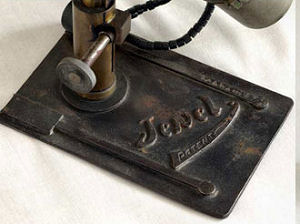 The Jewel. Ross' Carbon arc magic lantern light. |
| Carbon Arc
Burner made by Thomas Ross, London. The carbon rods are mounted on
electromagnetic arms. Arc point separation is controlled by the electric
current and thereafter automatically maintained at the correct separation. | ||
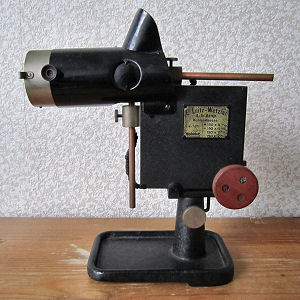 |
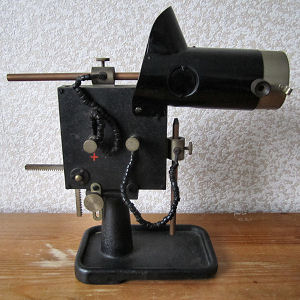 |
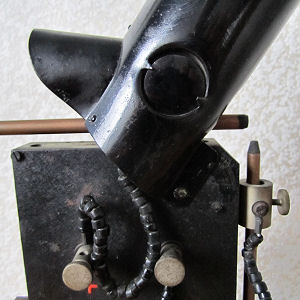 |
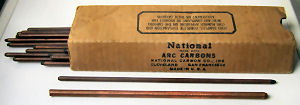 |
Carbon arc
burner made by Leitz-Wetzlar. 4-5 Amp. The lamp has a built-in lens that can by
removed when used in a magic lantern. | |
| Light bulb. | ||
|
The development of the electric
incandescent lamp at the turn of the 19th century stemmed the trend toward gas
lamps. Soon electricity was rapidly replacing gas for general illuminating
purposes. This resulted unfortunately in the discarding of many original light sources, like little oil lamps, which were often replaced by a simple socket, mounted on a piece of wood. Also the now unnecessary chimney often disappeared. That's why nowadays collectors often find a magic lantern from which the original lamp and/or chimney has disappeared. After 1910 the lanterns were more and more manufactured exclusively for electric lighting. | ||
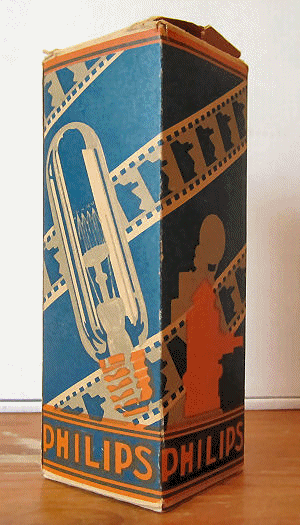 Electric projection bulb made by Philips, the Netherlands. |
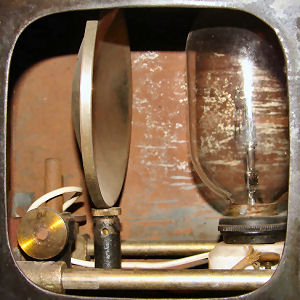 |
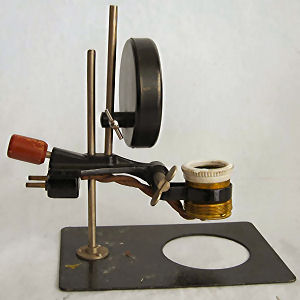 |
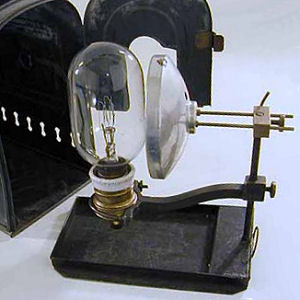 |
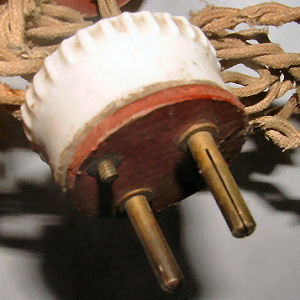 | |
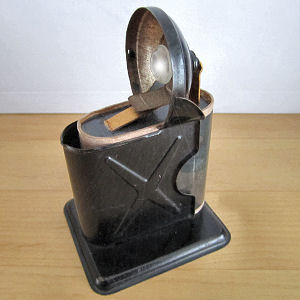 |
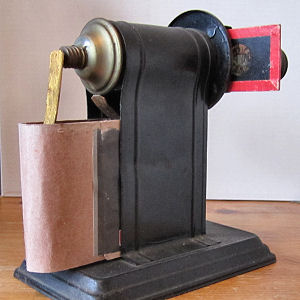 |
Light bulb for battery |
| The simple toy
lanterns could use a little light bulb, fed by a weak, and therefore children-safe, current. This
lamp has a built-in flat 4.5 V battery as also used in flashlights. Some toy lanterns had a built-in socket for such a small bulb in the back. | ||
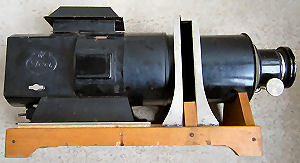 |
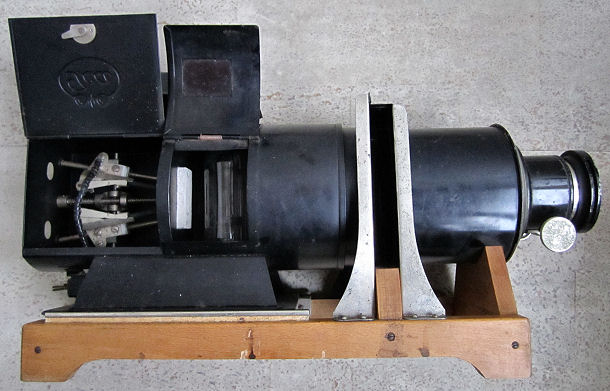 | |
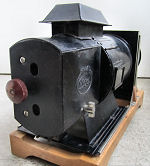 |
This very special magic lantern made by Ica, Dresden, is provided with an carbon arc illuminant as well as an electric bulb. | |
| |
©1997-2021 'de Luikerwaal' All rights reserved. Last update: 19-05-2021. |
|
